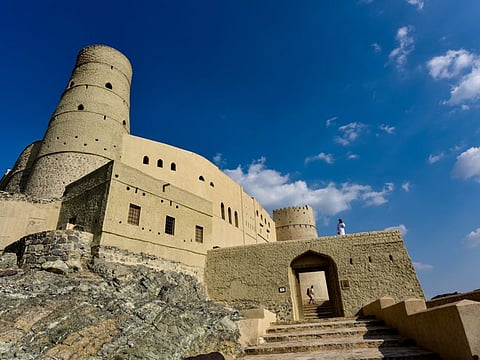Oman’s Bahla fort - where civilisations vie with legends
It sits pretty on Unesco’s list, with tales of walls built by jinns

Bahla, Oman: In the middle of a palm oasis, the Bahla Fort stands still as a witness to many ancient civilisations in Omani history.
The only Unesco-listed fort in Oman, which has walls and towers of mud bricks on stone foundation, dominates the surrounding mud brick settlement and palm grove.
The fort and settlement, a mud-walled oasis in the Omani desert, owed its prosperity to the Banu Nebhan tribe (Nabahina), who dominated the central Omani region and made Bahla their capital from the 12th century to the end of the 15th century.
Bahla, which was listed by Unesco in 1987, is known of its traditional markets, narrow districts and ancient mosques. It is an outstanding example of a fortified oasis settlement of the medieval Islamic period, exhibiting the water engineering skill of the early inhabitants for agricultural and domestic purposes
But the extensive Bahla wall that stands runs 13km has many legendary tales, making it famous - something like the Great Wall of China.
The wall with sentry walk and watchtowers enclosing the labyrinth of mud brick dwellings and cultivatable land has several gateways.
It is not clear who built Bahla wall as there are many tales and myths.
But the famous one is the legend of two sisters Maitha and Gaitha. The story goes that they built the wall in one night with the help of jinns.
Legend has it it that two sisters who lived in the city learned everything about magic. They were popular in the city for helping the people. Folklore passed through generations says the two sisters asked the jinns to build the wall in one night to protect the city from the invasion from nearby tribes.
Hamad Ali, a 31-year-old Omani Tourist Guide, told Gulf News that there are many myths and stories about the fort and the wall but nobody can confirm or deny it.
“The legend that two sisters Maitha and Gaitha built the wall. The fort was built before the Islamic era, and then the early Muslims came and build a mosque and other structures inside the fort. It is a mix of civilisations that inhabited this area and built a structure in the fort,” Ali said.
The Bahla Fort and oasis settlement, with its perimeter fortification, are an outstanding example of a type of defensive architectural ensemble that enabled dominant tribes to achieve prosperity in Oman and the Arabian Peninsula during the late medieval period.
The fort was restored a number of times over the centuries, first by the Nabhani tribe in the 13th century, then by the Yarubi tribe in the 17th century, and the Busaidi tribe restored it again in the 19th century.
The fort was in a sorry state in the second half of the last century, and the Omani government decided to start a serious restoration project in 1988, which was only finished in May 2012.
“It took more than 20 years of restoration, but a lot of people are very happy to see the fort after restoration. We receive many tourists and visitors every day who are keen to know the history of the country and teach their children about it,” added Ali.
The massive compound of the fort can easily take two or three hours to navigate if you want to examine each and every room. “Away from the legendary tales and myths, this fort is a symbol of Oman’s rich history.”
Restoration of Bahla Fort
It was put on the List of World Heritage in Danger in 1987.
Consolidation works to some sections of the fort, including Bayt Al Jabal, the entrance hall, and north-west and south-west walls using inappropriate materials were carried out in the early 1990s, and an audience hall in the courtyard was demolished in 1992.
From 1995, following training and advice on earthen structures, conservation using only earthen-based materials has included courtyard drainage, new roofs and consolidation of collapsing walls and towers.
The fort was taken off the List of World Heritage in Danger in 2004.
Bahla Fort and Oasis is protected administratively and legally under the Omani Law for National Heritage Protection (1980). The fort and its environs are controlled by the Ministry of Heritage and Culture in Muscat.
The site has a Management Plan dating from March 2005, focused on the long-term care, conservation and use of the site’s historic buildings and structures.
Falaj system
The Falaj irrigation systems of Oman are ancient water channels dating back thousands of years.
The Falaj system and water course on which the Bahla settlement depends, together with the historic routes linking the settlement to other towns in the interior, extend far beyond its boundary.
Sign up for the Daily Briefing
Get the latest news and updates straight to your inbox



